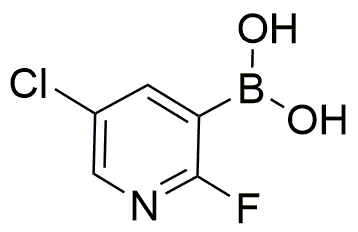5-Chloro-2-fluoropyridine-3-boronic acid is widely utilized in research focused on:
- Pharmaceutical Development: This compound is crucial in the synthesis of various pharmaceuticals, particularly in the development of targeted therapies for cancer, due to its ability to form stable bonds with biological molecules.
- Agrochemical Formulation: It serves as an important intermediate in the production of agrochemicals, enhancing crop protection products by improving their efficacy and reducing environmental impact.
- Material Science: Used in the creation of advanced materials, this boronic acid derivative contributes to the development of polymers and composites with enhanced properties, such as improved thermal stability and mechanical strength.
- Organic Synthesis: It plays a significant role in cross-coupling reactions, which are essential for constructing complex organic molecules, making it a valuable tool for chemists in both academic and industrial settings.
- Diagnostic Applications: The compound is being explored for use in diagnostic assays, particularly in the detection of biomarkers, thereby aiding in early disease diagnosis and monitoring.
General Information
Properties
Safety and Regulations
Applications
5-Chloro-2-fluoropyridine-3-boronic acid is widely utilized in research focused on:
- Pharmaceutical Development: This compound is crucial in the synthesis of various pharmaceuticals, particularly in the development of targeted therapies for cancer, due to its ability to form stable bonds with biological molecules.
- Agrochemical Formulation: It serves as an important intermediate in the production of agrochemicals, enhancing crop protection products by improving their efficacy and reducing environmental impact.
- Material Science: Used in the creation of advanced materials, this boronic acid derivative contributes to the development of polymers and composites with enhanced properties, such as improved thermal stability and mechanical strength.
- Organic Synthesis: It plays a significant role in cross-coupling reactions, which are essential for constructing complex organic molecules, making it a valuable tool for chemists in both academic and industrial settings.
- Diagnostic Applications: The compound is being explored for use in diagnostic assays, particularly in the detection of biomarkers, thereby aiding in early disease diagnosis and monitoring.
Documents
Safety Data Sheets (SDS)
The SDS provides comprehensive safety information on handling, storage, and disposal of the product.
Product Specification (PS)
The PS provides a comprehensive breakdown of the product’s properties, including chemical composition, physical state, purity, and storage requirements. It also details acceptable quality ranges and the product's intended applications.
Certificates of Analysis (COA)
Search for Certificates of Analysis (COA) by entering the products Lot Number. Lot and Batch Numbers can be found on a product’s label following the words ‘Lot’ or ‘Batch’.
*Catalog Number
*Lot Number
Certificates Of Origin (COO)
This COO confirms the country where the product was manufactured, and also details the materials and components used in it and whether it is derived from natural, synthetic, or other specific sources. This certificate may be required for customs, trade, and regulatory compliance.
*Catalog Number
*Lot Number
Safety Data Sheets (SDS)
The SDS provides comprehensive safety information on handling, storage, and disposal of the product.
DownloadProduct Specification (PS)
The PS provides a comprehensive breakdown of the product’s properties, including chemical composition, physical state, purity, and storage requirements. It also details acceptable quality ranges and the product's intended applications.
DownloadCertificates of Analysis (COA)
Search for Certificates of Analysis (COA) by entering the products Lot Number. Lot and Batch Numbers can be found on a product’s label following the words ‘Lot’ or ‘Batch’.
*Catalog Number
*Lot Number
Certificates Of Origin (COO)
This COO confirms the country where the product was manufactured, and also details the materials and components used in it and whether it is derived from natural, synthetic, or other specific sources. This certificate may be required for customs, trade, and regulatory compliance.


